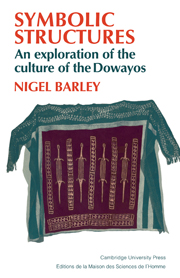Book contents
- Frontmatter
- Contents
- Acknowledgments
- Preface
- 1 The ethnographic background
- 2 Symbolism and the punctuation of culture
- 3 Some problems of the representational model of symbolism
- 4 The leopard cannot change his spots
- 5 Water and fertility
- 6 Tarniisnohgbarklele: ‘the place where the old Fulani woman was beaten to death’
- 7 ‘It is only thanks to me that you were circumcised’
- 8 The seasons of the year and the joker in the pack: relations of nesting and quotation
- Appendix: The festivals
- Notes
- Bibliography
- Index
1 - The ethnographic background
Published online by Cambridge University Press: 07 May 2010
- Frontmatter
- Contents
- Acknowledgments
- Preface
- 1 The ethnographic background
- 2 Symbolism and the punctuation of culture
- 3 Some problems of the representational model of symbolism
- 4 The leopard cannot change his spots
- 5 Water and fertility
- 6 Tarniisnohgbarklele: ‘the place where the old Fulani woman was beaten to death’
- 7 ‘It is only thanks to me that you were circumcised’
- 8 The seasons of the year and the joker in the pack: relations of nesting and quotation
- Appendix: The festivals
- Notes
- Bibliography
- Index
Summary
The Dowayos are a pagan, montagnard people numbering some fifteen thousand and living in the Poli region of north Cameroon, West Africa, close to the Nigerian border (see fig. 1). Hitherto, they have been largely grouped together with other pagans of that area – such tribes as the Koma, Bata, Pape (Dupa) and Ninga – under the general term Kirdi or the highly pejorative Namchi. Even the French colonial administration was unable to fix on a firm division of these peoples between Poli and the Nigerian frontier, and many of the works purportedly dealing with the Dowayos deal instead with the Koma or the Pape, or cannot be definitely assigned to the ethnography of any one single group.
The area is dominated by the Fulani. Sedentary Fulani run the cities and major towns throughout the north, while nomadic Fulani claim rights of passage in the dry season when they come down in search of grazing. Poli is regarded by Dowayos as a blatant Fulani incursion into their territory. The various groups define themselves, above all, in opposition to the Islamic Fulani, who regarded the whole area as a hunting reserve for domestic slaves and levied various forms of tribute until recent times.
The Dowayos themselves have a very firm notion of who they are and disclaim all kinship with surrounding peoples. They divide themselves into two groups, mountain Dowayos (Teehreh) and plains Dowayos (Markeh). These terms are self-explanatory to a certain degree but there exists the feeling that mountain Dowayos are more traditional and hold to the old ways better, that they are more truly Dowayo.
- Type
- Chapter
- Information
- Symbolic StructuresAn Exploration of the Culture of the Dowayos, pp. 1 - 9Publisher: Cambridge University PressPrint publication year: 1983

